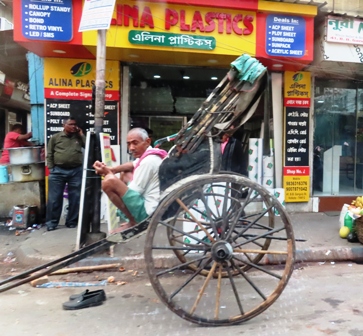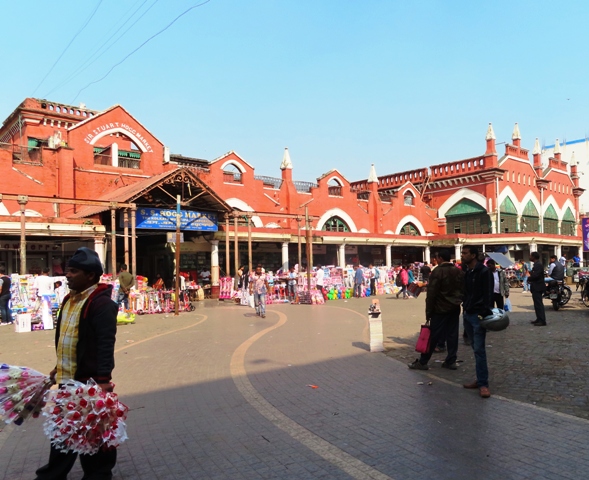Metropolitan Building in Kolkata
By Jug Suraiya

Calcutta may not know it—and if it does it might not care—but there are a number of offshoots of the community flourishing across the globe.
'My relationship with this city is like that of a spectator watching a man walking across a tightrope. Each time you turn around and look you're sure he must have fallen off. But no— by some miracle he's still on the line. Teetering and swaying but still up there. It's fascinating in a morbid sort of way. You find yourself getting hooked coming back again and again. Each time I come back things are that much worse that much crazier. But I keep returning and I guess I always will.'
The speaker is a middle-aged Bengali who lives and works in New York. But in one respect he is representative of a diverse cross-section of people of various backgrounds and occupations who, scattered across the world from Melbourne to Memphis and from Hounslow to Hong Kong, maintain a tenuous but lasting long-distance connection with Calcutta the city they once lived in.
Perhaps no other place exercises quite the same kind of lure composed of about equal parts of nostalgia and anger. With its frailties and foibles its all too human shortcomings and lapses Calcutta is like a rundown old relative—eccentric cantankerous infuriating impossible to live with perhaps but equally impossible to cut oneself off from.
It seems to evoke an enduring sentimentalism a blend of happy memories that the city provided when it was in its prime and a nagging sense of something akin to duty towards it now that it has fallen on hard times. Like visiting a relative one has grown up with, coming back to Calcutta can prove an emotionally confusing experience.
‘I was totally disoriented when I got back' says a visitor from America. ‘Chowringhee and Park Street which I'd always thought of as such impressive roads seemed so dwarfed. Everything looked so dingy and small. It took me a while to realise the city couldn't have got smaller; what had happened was that I'd grown up. I guess I'd never stopped seeing the place through the eyes of a child even in my memories.'
Then there are those who have not come back to Calcutta but have not forgotten it either. In letters to friends and relatives they ask after people and places that have long since vanished. They inquire about shops and restaurants which disappeared years ago, sports teams which have disbanded, buildings which have been swallowed up in construction projects, gala occasions which have faded into neglect.
‘Sometimes I don't know what to write in reply' says a Calcuttan. ‘I mean it's almost like breaking the news about a death in the family.'
Do the Armenians still play the LMOB in the Rugby League? Do they still have Saturday night dances at the Grail Club? Is Pehalwan still there at Nizam's to take orders for kababs at two in the morning, and do the kathis still taste as good? And at the stroke of midnight on New Year's Eve do the sirens of the steamers on the Hooghly still sing out while the foo-foo band wheezes Auld Lang Syne and strangers exchange salutations of the season on the thronging pavements of Park Street?
Like a fly in amber a distant city is preserved in memory a remembrance of times past. The loneliness of the long-distance Calcuttan caught between two worlds springs from a realisation of double exile. All emigrants experience the paradox of displacement: You don't have a home till you leave it and when you do you find you can't go home again.
But in the case of Calcutta this feeling is compounded by a sense of dislocation in time as well as space. Perhaps because—as its critics claim—it is a place with a past but no future, the city is capable of inducing a virulent and chronic attack of nostalgia. In a sense Calcutta is everyone's childhood measles, mumps, and all.
The emigrant experience is perfectly suited to a transplant of Calcutta. And since this can't be done with the real city a mythical one has been invented to fit the need an emotional precinct of love and squalor. Beyond the reach of urban blight and civic neglect this portable city of the mind flourishes all the more as the real one declines.
‘Every time we meet, we end up talking about Cal. It's the one thing we have in common' says a Sydney-based airline executive referring to the ‘old mob from back home'. And then he adds ‘But none of us has been back in years.'
Like the words of an old song that keep repeating themselves in your head or a fever dormant in the blood or an importunate lover impossible to be rid of, it keeps returning again and again at the oddest times and in the strangest places. In Balham, London or Kings Cross, Sydney or Queens, New York whenever ex-Calcuttans meet the talk turns to Chowringhee and Chetla Ripon Street and rickshaws.
Random, haphazard, raucous, the city lives again. For Calcutta as many have discovered is a moveable adda.

Jug Suraiya - Writer/columnist and author of several books.
Published: 23rd June 2019